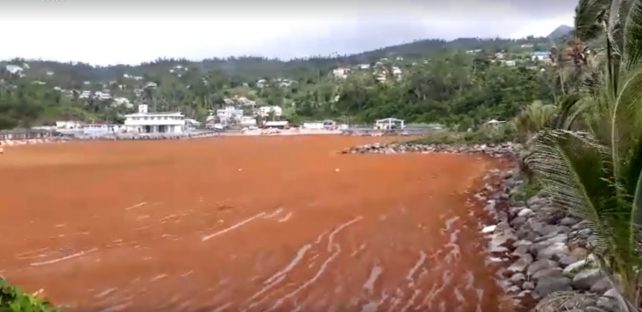
For several years now, I have witnessed an increase in this brown seaweed with its berry-like clusters. Research into this has been impressive as to this “strange brown mass” which seems to invade our coastal waters.
Sargasso seaweed (Sargassum) is marine algae that are so abundant in the ocean that it now “clogs” several of our coastal and fishing areas around Dominica and neighboring islands.
This seaweed generally occupies a large area in the Atlantic Ocean about the size of the Continent of Europe.
Interestingly though, if you look closely at a sample of the seaweed, it is easy to see the many leafy appendages, branches, and round, berry-like, structures that make up the plant. These “berries” are called pneumatocysts, which are filled mostly with oxygen. The oxygen-filled pneumatocysts are part of the plant structure that helps it to float on the water surface.
A floating mass of Sargasso seaweed can stretch for miles across the ocean. These large masses provide food, protection, and breeding grounds for several marine species such as fishes, sea turtles, marine birds, crabs, shrimp, and others. Sargassum is a primary nursery area for a variety of commercially important fishes (NOAA Ocean Explorer, 2018).
When Sargasso Seaweed loses its ability to float, it sinks to the seafloor and provides energy, in the form of carbon, to fishes and invertebrates in the deep sea. Sargassum has potential to contribute to the food sources deep in the ocean (NOAA Ocean Explorer, 2018).
In 2005, scientists used a type of net called a neuston net to sample surface waters in the Gulf of Mexico. In towing the net for only one 15-minute period within an area of Sargassum, they collected over 3,000 fish in 180 pounds of Sargasso seaweed (NOAA Ocean Explorer, 2018).
It proves the point of the ecological value of Sargasso seaweed to marine species. Because of its ecological importance, Sargasso seaweed has been classified as Essential Fish Habitat.
This designation gives special protection to these areas (NOAA Ocean Explorer, 2018). Sargasso seaweed also helps protect beaches from erosion. Research continues on the possible use of this seaweed such as an organic fertilizer for farming, material for soil composting, and others.
As World Oceans Day was recognized, internationally, on June 8, 2018, let us take some time from our busy schedule to learn and appreciate more about the ocean and marine resources.
Miguel Shillingford is from the Forestry, Wildlife and Parks Division Environmental Education Unit

This is a well written statement.
Sargassum need not be a hindrance to Dominica, and could well be an asset.
I saw a video on Whats Appm by a man from marigot, which associated Sargassum with Hurricane Maria. That was pure superstition.
It is up to entrepreneurs to find a commercial way to utilise this asset.
Thank you for the extra info
Thanks for the brief info but it didnt say where exactly it came from, why the mass arrival of the weed, its causes during this time of year.
It is thought to be coming from the coast of Africa.
I collected some a few years ago when it swamped Scott’s Head and after leaving it for a few months for the rain to wash out the salt I used it as a mulch on my vegetable beds. It suppressed the weeds for ages and later I dug it in. It has improved the quality of my soil amazingly.
Wonderful Miguel. I wondered what this brown floating stuff was. Thanks for the info
Nice….Real truth in this article….very good….
Nice article Miguel. Informative.